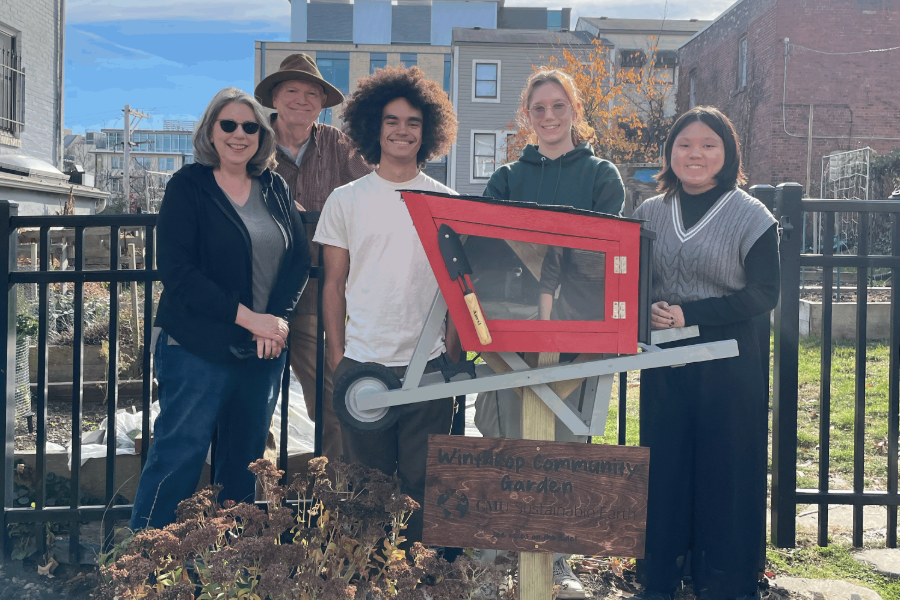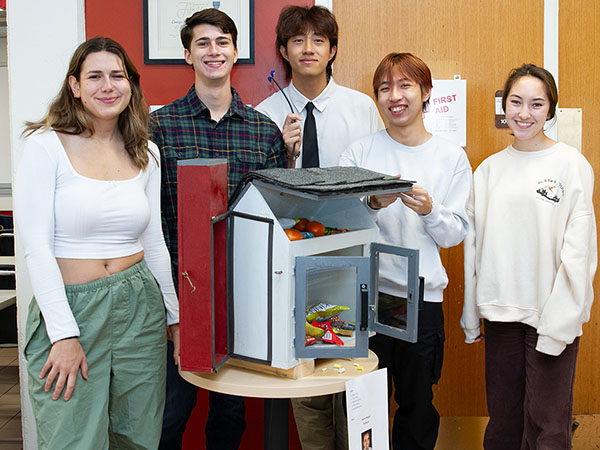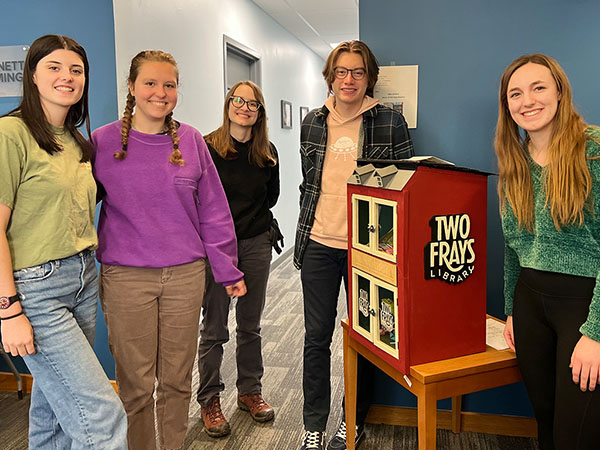
Classroom to Community: Designing Little Free Libraries in CEE Project Course
CEE’s 12-200 project course teaches students the design process and how to implement it in challenging, unstructured problems. It is the stepping stone towards classes like the Junior-level project course, 12-301, which utilizes the design process fundamentals to approach more complex, CEE-specific problems.
Professor Katherine Flanigan and Facilities and Lab Engineer Brian Belowich came up with a new project for the course where students would work with a client to design and build a Little Free Library that would then be installed at the client’s homes or businesses.
Little Free Libraries, or “Lending Libraries,” are small book exchange boxes placed in public areas that are designed to promote literacy and a sense of community. There are many throughout Pittsburgh, some even filled with canned goods or hygiene products. In 12-200, students learned that these simple structures could even be retrofitted as a means of citizen-led environmental data collection, providing insights on critical issues facing communities.
“Working with somebody who was going to guide the design objectives and constraints, as well as receive the end product, completely shaped their approach to the design process and professionalism,” says Flanigan. “It forced the students to think explicitly about design function and what role the structure would play within the community—no two stakeholders had the same vision of how this project would interface with their communities.”
Belowich held training and working sessions at Tech Spark with each group, going over woodwork and safety, and helping them construct their libraries. For the students to get the maximum benefit from Tech Spark, each group was required to make everything out of wood and incorporate a laser component and 3D printing component.
A crucial part of the design process is budgeting, which Flanigan and Belowich incorporated into the project by giving each group a budget of $200. Reusable materials were cheaper, to incentivize recycling. “The goal was not to limit their designs, but to encourage them to think about cost, ease of construction, and environmental factors such as waste,” says Belowich.
Belowich hopes the Little Free Library project taught students how important the design of anything is, before you start cutting and building. At the time of construction, many students asked questions about things that should have been addressed in the design process, like shingling a roof.
"Overall, the students were positive about what they did, what they learned, and what they achieved,” says Belowich.
The Projects

Sensor Library
Team: Lillian Keith, Matteo Perillo, Kat Studentsova, Yujun Wu, Tian Zhou
Client: Mario Bergès
Professor Bergès asked for the library to serve as an interactive focal point for the neighborhood, providing book storage and the possibility of accommodating additional space for household tools. He emphasized the importance of making the library visually appealing to children to encourage reading. He also specified that the final design should harmonize visually with the neighborhood, prompting the team to consider existing architecture and landscaping while developing their proposed designs.
In alignment with Bergès' expertise in sensing technology, he requested the students integrate sensors for data collection, such as air quality and other environmental parameters of interest to the community, to be measured. Additionally, using solar panels for power was specified as part of his requirements.

Castle Library
Team: Edwin Chen, Chase Gumbs, Jordyn Le, Jana Reiser, Ella Vander Velde
Client: Andrea Francioni Rooney
The library designed for Andrea Francioni Rooney houses books and was inspired by the role-playing game Dungeons and Dragons. Installed at her home near a retirement community and a school bus stop, Francioni Rooney prioritized accessibility for all community members in their design. Additionally, the team integrated solar panels to power interior lighting, ensuring better visibility during the evening hours.
The team considered both the height of the library and the convenience and durability of the opening and design elements. In response to potential wear and tear, they opted for sturdier materials, chosen to endure harsh weather conditions with greater resilience.

Burton-Gothic Library
Team: Bea Holzbach, Brian Spradley, Luis Hierro, Margarita Cejudo Arita, Liting (Belle) Jiang
Client: Melissa Ritchie
The client required that the finished project be able to accommodate a minimum of 20 books in the library. The little library was intended for installation in front of her home to facilitate book exchanges among neighbors. The team emphasized using recycled materials, integrating 3D printing and laser-cut details into the final design. Additionally, durability in diverse weather conditions was a key consideration.
Ritchie prioritized the project's aesthetics, requesting that the team craft an eye-catching, Tim Burton-esque, cartoonish Gothic-style library. She also specifically requested a shiplap exterior for the design.

Two Frays Brewery
Team: Ester Schneiderova, Carly Najarian, Jose Echeverria, Aurora Fuchs, Molly J Smith
Client: Mike Onofray
This project was undertaken for Mike Onofray, the proprietor of Two Frays Brewery. His primary focus was to craft a communal space where patrons could exchange books and gain insights into brewing intricacies by featuring relevant books on a dedicated shelf. The library's appearance harmonizes effortlessly with the brewery, seamlessly integrating into the space. The students also included a laser-engraved version of the brewery's logo as part of the design.
The stakeholder, being a private business owner, unaffiliated with the university professionally, also introduced an additional layer of complexity in communication and coordinating meetings, mirroring real-world challenges when working with external clients.

Winthrop Community Garden Library
Team: Izzy Williams, Ali DeLorenzo, Angela Fan, Lex Capestany
Client: Sarah Fakhreddine and Lisa Long
This communal garden is a shared green space for both the CMU and Oakland communities, cultivating vegetables and native plants. Grow Pittsburgh, the primary sponsor of the garden has established specific criteria for public greenspaces, including the display of rules and contact information. Unfortunately, the existing signage had deteriorated. The clients sought to create a visually appealing and long-lasting sign that adheres to community guidelines and incorporates a lending library.
Prioritizing sustainability goals, the team utilized predominantly recycled materials for their construction to minimize waste. Addressing stakeholder concerns, durability became another key focus, ensuring the finished piece could withstand various weather events. Additionally, the team provided flexibility to the group by designing the sign to be easily replaceable, allowing for the straightforward swapping out of rules or guidelines as needed.

Little Free Closet
Team: Samatha Vu, Lauren Oh, Kundhavi Tiruchinapalli, Jaden McCleery Brown, Naveen Khalil
Client: Cathy Schaefer
This project had a unique focus on sharing gently used clothing within the community, diverging from the conventional library setup with books, and aimed at minimizing textile waste. Following the client's brief, the students were challenged to design and construct a larger structure for the "closet." Additionally, Schaefer emphasized the importance of incorporating appealing finishes and providing clear information about its purpose to engage the community.
The completed closet is planned to be installed at the local Jewish Community Center.